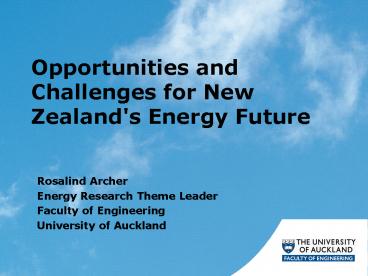Opportunities and Challenges for New Zealand's Energy Future - PowerPoint PPT Presentation
1 / 24
Title:
Opportunities and Challenges for New Zealand's Energy Future
Description:
Opportunities and Challenges for New Zealand's Energy Future Rosalind Archer Energy Research Theme Leader Faculty of Engineering University of Auckland – PowerPoint PPT presentation
Number of Views:220
Avg rating:3.0/5.0
Title: Opportunities and Challenges for New Zealand's Energy Future
1
Opportunities and Challenges for New Zealand's
Energy Future
- Rosalind Archer
- Energy Research Theme Leader
- Faculty of Engineering
- University of Auckland
2
- Source United Nations Environment Program,
Global Trends in Sustainable Energy Investment,
2011
3
International Context
- Source United Nations Environment Program,
Global Trends in Sustainable Energy Investment,
2011
4
International Statistics
- 2008 2009 2010
- Investment in new renewable capacity
(annual) 130 160 211 billion USD - Renewables power capacity (existing) 1,140 1,230
1,320 GWe - Hydropower capacity (existing) 950 980 1,010
GWe - Wind power capacity (existing) 121 159 198 GWe
- Solar PV capacity (grid-connected) 16 23 40 GWe
- Solar hot water capacity (existing) 130 160 185
GWth - Ethanol production (annual) 67 76 86 billion
liters - Countries with policy targetsfor renewable
energy use 79 89 98
Source Wikipedia
5
NZ Electricity
Source NZ Energy Quarterly, Ministry of
Economic Development, June 2011
6
NZ Electricity Projections
Source NZ Energy Outlook, Ministry of Economic
Development, 2010
7
NZ Oil
Source NZ Energy Quarterly, Ministry of
Economic Development, June 2011
8
NZ CO2 Emissions
Source NZ Energy Quarterly, Ministry of
Economic Development, June 2011
9
Fossil Fuels Challenge
- Domestic oil production in decline. Oil price?
- Energy Outlook assumes 120 PJ per annum new gas
production from 2017 to 2030. Exploration?
10
Gas Hydrates
- GNS estimates NZ could have 5 to 50 tcf of
methane recoverable from hydrate deposits (Maui
4 tcf) - Recovery process? Economics?
11
Coal
- Can natural gas be produced practically and
economically from coal-beds in NZ? - Underground coal gassification being trialled by
Solid Energy.
Image www.gwv.co.za
12
Carbon Dioxide Sequestration
- Can carbon dioxide be safely and effectively
stored underground? - Subsurface pore space that is the most well
understood is depleted oil gas reservoirs, deep
saline aquifers have large volumes. - Public perception/confidence?
13
Geothermal Energy
- How did our deep geothermal systems evolve, how
should they be best produced? - Projects planned to produce deeper resources and
use binary plants to produce lower temperature
resources.
Image Courtesy of Prof. Mike OSullivan
14
Enhanced Geothermal Hot Dry Rock
- Cold water injected into one well and produced as
hot water via another well. - Likely to require fracturing.
Image http//esd.lbl.gov/IMG/research/projects/in
duced_seismicity/egs/Geothermal-Plant.gif
15
Wind Energy Wind Farm Design
- Novel wind speed monitoring devices.
- How should wind flow be modelled in complex
terrain? - Where should turbines be placed (optimally)?
Image Courtesy of Stuart Donovan
16
Wind Energy - Challenges
- Offshore wind developments?
- Environment court/RMA approvals?
Image http//www.windenergyplanning.com/european-
offshore-wind-supergrid-deal-signed/
17
Wind - Economics
- NZ Wind Energy Association believes wind can
generate 20 of our electricity. - Economic modelling by Infometrics suggests
development of more wind energy could mean every
New Zealander would be 390 better off per annum
by 2030 (assuming an increase in wholesale gas
prices and a carbon price of 50/tonne).
18
Tidal/Wave Energy
- Crest Energys Kaipara project was approved in
early 2011. - Movement of 8,000 million cubic metres of water
through the harbour will be harnessed to generate
200 kW electricity. - IRL marine generator being tested off Wellington.
- Will this lead to more development?
Image Pelarmis device, Wikipedia
19
Biofuels/Bioenergy
- Novel process developed to react vaporised tallow
with methanol to create bio-diesel. - By 2040, 30 of NZs transport fuels could be
derived from Biomass (BERL, August 2011)
largest fraction from woody biomass and short
rotation crops.
20
Green Energy Systems
- Use of an electric vehicle, which already has a
powerful battery, not just for mobility but also
to supplement existing household energy storage
as appropriate.
Likely to help increase the penetration of wind
energy into the grid.
Image Courtesy of Dr Udaya Madawala
21
Inductive Power Transfer
- Wireless transfer of electric charge applicable
to electric vehicle charging. - Toll lanes to charge vehicles on motorways?
- Parking spaces that charge your vehicle while you
park?
Image www.haloipt.com
22
Green Computing
- Data centres consume 0.2 of world electricity
and emissions could quadruple by 2020 (McKinsey) - Optimisation models for automatic design of
clustered data storage systems, leading to
reduced energy consumption.
23
Phase Change Materials
- How can we use phase change materials to improve
energy efficiency?
Image Courtesy of Prof. Mohammed Farid
24
Closing Remarks
- Technology only one factor in advances in
renewable. - Policy, regulation, and social acceptance also
very important.































